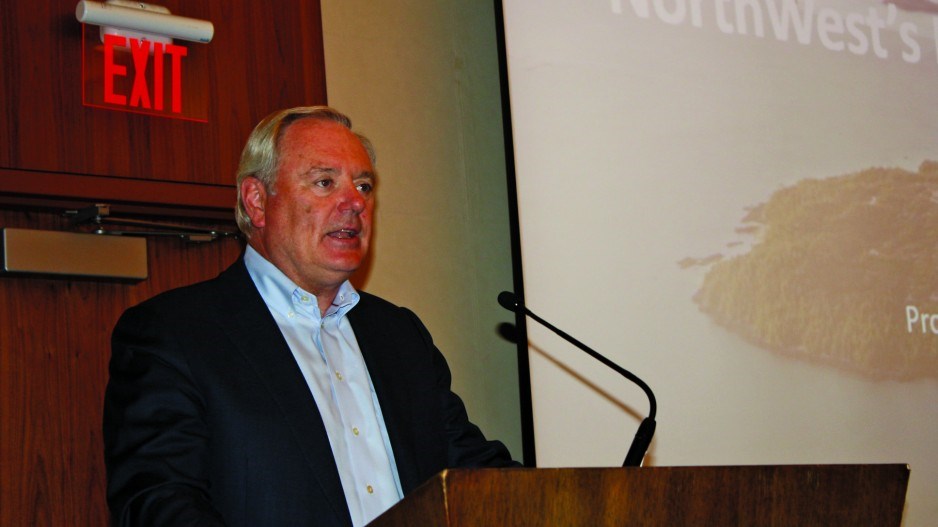Would an NDP or Liberal win in October’s federal election kill or stall plans by Petronas to build B.C.’s first liquefied natural gas plant?
The possibility of a new party in power in Ottawa appears to be less of a worry for the company than the bureaucrats there, according to Michael Culbert, president of Progress Energy and Pacific NorthWest (PNW) LNG.
At an August 25 LNG conference in Vancouver sponsored by AltaCorp Capital, Culbert told investors, analysts and other industry players that the delays the $36 billion project has suffered in the ongoing Canadian Environmental Assessment Agency (CEAA)review were frustrating, given his company’s cash burn rate of $2 billion per year.
The CEAA has hit the pause button several times now in an environmental review process that was streamlined in 2012 to get CEAA reviews completed within 365 days.
“We’re on Day 662 of that process,” Culbert said.
The most recent delay in the CEAA process has been over concerns about the environmental impact of a suspension bridge to convey LNG from a liquefaction plant on Lelu Island to an offshore marine terminal adjacent to Flora Bank, a sensitive eelgrass bed in the Skeena River estuary.
Those concerns led the Lax Kw’alaams Band – one of five key First Nations in the area – to reject a $1.1 billion benefits agreement offered by the company. As Culbert pointed out, benefits agreements have been reached with the other key First Nations in the Prince Rupert region.
“The bulk of the First Nations really are supportive of the LNG project,” he said.
A moderator has also been appointed to help the company and Lax Kw’alaams resolve some of the outstanding concerns, and the company now plans to conduct some drilling tests to see if the bridge can be modified or shifted to address concerns over impacts on fish.
“We believe we can get through that and bring the Lax Kw’ alaams on board, although it’s going to be at the 11th hour, I’m sure,” Culbert said.
The Lax Kw’alaams issued a press release last week that suggests the First Nation might still accept the project.
“While the federal government [Ministry of Natural Resources] has been a tremendous disappointment, the provincial government appears to be making a concerted effort to understand fully the concerns of Lax Kw’alaams, in particular as they relate to Flora Bank,” the press release stated.
“A protocol has been established to do investigative drilling in aid of determining an alternative site, away from the Flora Bank, for the shipment of any LNG from Prince Rupert harbour.”
If the company resolves some of the main Lax Kw’alaams concerns, Culbert said he is confident the project can proceed, regardless of which party forms the next government.
In June, Petronas shareholders approved a final investment decision on the $36 billion project. Its Canadian subsidiary, Progress Energy, has already spent $5 billion in B.C. developing its upstream natural gas assets in northeastern B.C.’s Montney region, Culbert told Business in Vancouver.
The company is spending roughly $2 billion a year just on its upstream natural gas network.
In 2014 alone, it drilled 203 new wells (at $7 million per well), 10 compression stations, a gas plant and 900 kilometres of feeder pipeline – activity that has been employing a workforce of approximately 4,000.
It plans to drill another 175 wells this year. To get up to the capacity needed to feed its two-train LNG plant in Prince Rupert, it plans to drill 1,200 wells over the next five years.
With North American natural gas prices at US$2.70 per million British thermal units, that kind of investment would make little sense, were it not for the value-added proposition that LNG and natural gas liquids provide.
The Montney is rich in natural gas liquids, such as butane, propane and condensate, which fetches a premium in the Alberta oilsands, where it’s used to dilute the thick bitumen so it can flow through pipelines.
Progress is currently selling condensate to Alberta and selling its dry gas into the North American gas market. But should the PNW LNG project proceed, it will start moving the gas it is producing through a new 900-kilometre pipeline to Prince Rupert, which is yet to be built.
Though there are about 19 LNG projects proposed for B.C., the consensus among analysts and industry players is that only three will get built, and PNW LNG is the clear front-runner.
The project is unique in that it is fully integrated. Petronas owns every link in the chain – from the upstream gas assets to the tankers that will move LNG to Asian markets.
It also has built-in buyers in its partners. Petronas owns 62% of the PNW LNG project, Sinopec 15%, Japex 10%, IndianOil 10% and Petroleum Brunei 3%.
“Unlike other projects that say, ‘What’s the demand? Where’s my contract?’ we’re in a situation where our partners have their own demand for LNG,” Culbert said.
“Petronas also has increasing demand for natural gas in their own country, so they’re looking to substitute, retain market share [and] grow market share by having a diverse supply out of Malaysia, Australia and Canada.”
Even so, Culbert admitted that it’s sometimes hard to justify the kind of investment it has been making in B.C. when the environmental review process keeps getting delayed.
“There’s definitely some angst just from a cash-flow perspective,” he said.
Like all other oil and gas companies, Petronas has been hit with falling oil and gas prices. It posted a second-quarter decline in revenue of 28% compared with Q2 2014, and a 33% drop in cash flow.
A final CEAA decision is not expected until after the October 19 federal election.




